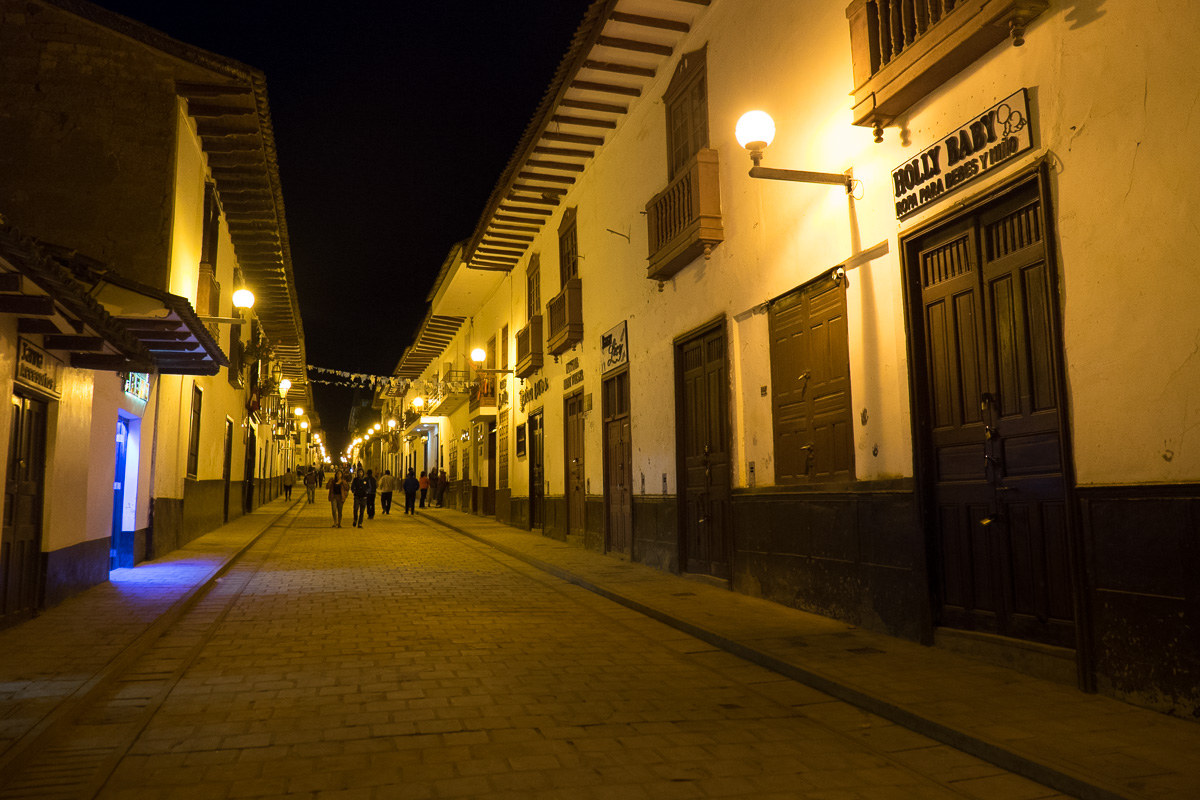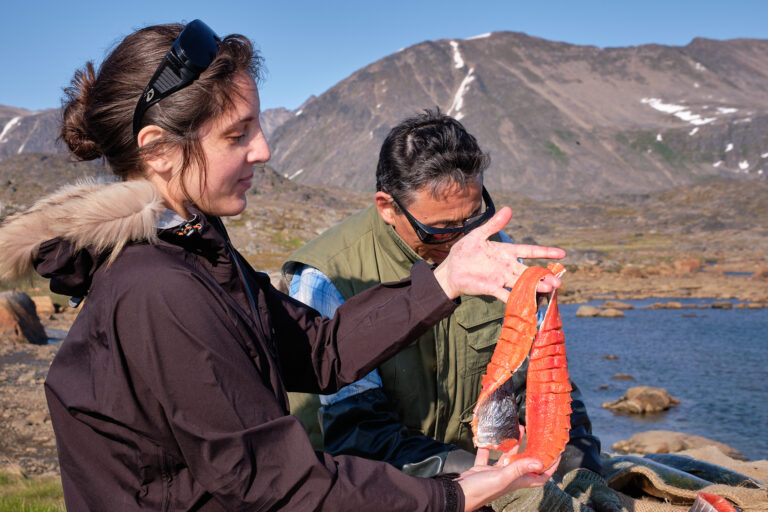Kuelap – Chachapoyas, Peru
Chachapoyas is a long way from anywhere in Peru but, if one looks at it a certain way, it is on the way to Tarapoto where I was headed to do the Vegetarian Cooking and Yoga retreat. I decided to head here (as opposed to Cajamarca or Chiclayo which were my other options) because of some cool-looking pre-Incan archaeological sites, even though it meant an 8-hour overnight bus from Huaraz to Trujillo, 10 hours waiting in the bus station in Trujillo, and then another 10 hour overnight bus from Trujillo to Chachapoyas – I guess at least I saved money on accommodation!
Chachapoyas itself is actually quite lovely – if you can ignore the fact that they have dug up all the roads at once, even though they only seem to be working on a single block. The buildings in the centre are in great shape and beautifully whitewashed, there is a pedestrian street that is filled with people every night and a lovely central square. There’s also some great food to be had!

I only had 2 days in Chachapoyas, so the first day I headed out to the main architectural site – Kuelap – one of the largest and most important sites for the Chachapoyas people (the “Warriors of the Cloud”) who existed well before the Incas. The site itself dates from about the 6th century AD through to the arrival of the Spanish in the mid-16th century, and although it was rediscovered in 1843, it was not investigated archaeologically until 1997.
So at 8:30am I was bundled into a minivan with a bunch of other people (all locals – it’s a good thing I speak Spanish!) and off we headed on the very, very slow journey to the site. Kuelap is only ~70km from Chachapoyas, but it took us 2.5 hours to get there! Admitted the road was essentially single-lane for a lot of it, but I do think we had the slowest and most careful driver in the world as an added bonus.
Our first glimpse of Chachapoyas construction came at the 1-hour mark when we pulled off the side of the road for a view across the Utcubamba river to Macro – a site used for agriculture and burials.

Then it was onward to a town where we pre-ordered lunch and I got my first experience of how frustrating this day would be. We were stopped there for almost an hour because some of my fellow companions had bought a Mate de Coca and weren’t allowed to drink it in the van. We had to wait for them to finish – but they certainly took their time about it!
Then it was another hour up to the visitors centre where we bought entrance tickets. Another whole bunch of pfaffing before we started the 2km walk up to the site itself. Oh my God! They all walked soooooooo slowly! OK – so admittedly I’d just finished trekking for 10 days at altitude and so was in good shape – but still. As the guide, Ivan, joked with me – they were like tortoises. I suggested that they were more like mostly-dead tortoises…

We eventually made it to the site and Ivan did a really great job of explaining what we were seeing – it was a great tour once we got there, and for the first time ever – I wasn’t the only one asking questions 🙂

Essentially the best guess at the minute is that Kuelap was a military fort and a ceremonial centre with about 3000 people living there. It is built on 3 levels with the uppermost level, obviously being for the most important people – the “retaining wall” that supports the upper level is considered the best construction work done by the Chachapoyans, though there are lots of very long, very tall and very thick walls that feature at the site (some walls are 80cm thick and reach up to 20m in height).

There are 3 entrances to the city – unfortunately the main entrance is closed because it is unstable, so we entered through what they think was the “common people” and animals entrance. There are even llama imprints in the stone! The entrances were constructed so they were wide enough to admit several people initially, but narrowed to only admit one person to the city in the end – an example of the strategic design of the city.

Chachapoyan architecture is very, very different to that of the Incas – the site is composed of 460 circular structures and only 5 rectangular ones (these latter were constructed when the Incas came and conquered the Chachapoyans). Each of these round dwellings had walls about 4-5m high and housed 5-6 people – the replica in the image below was created about 17 years ago. The irony is that the wooden supports etc are not part of the design – they are there to support the structure which is crumbling after only this short amount of time. Yet the Chachapoyan walls have stood for over two thousand years…

Inside these dwellings you can see niches in the walls for placing important items, cooking stones and even a “guinea pig run” (the long covering of stones) where they bred and kept guinea pigs for eating. Some also had a central “well” that they used initially as a food store (kind of like a refrigerator) but also to place the bones of their deceased.

On the outside of some of the dwellings, those occupied by the religious leaders, there was stonework that depicted the eyes of the Gods, in particular the eye of the Condor (left) and the eye of the Puma (right; note the vertical in the middle of the diamond – like a cat’s eye). They also had “eaves” of stone to protect the foundations from the rain (seen above the pattern on the right).

One of the most important structures in the site is at the southern end – the Templo Mayor (Main Temple). It is a solid stone construction (5m high and 13.5m in diameter at the top) in the form of a truncated and inverted cone with a narrow inner, bottle-shaped cavity. It is believed that this was a religious construction (especially given the existence of the face of a deity – the only one in the site outside of the primary entrance) and evidence has been found for human burials and other rituals.

Another important structure was located at the northern end of the site in the highest part of the city – the Torreón. 7m high, they believe it wasn’t used for military purposes, but rather rituals, even though slingshot projectiles were found near the structure. There are also amazing views from here 🙂

We also visited the structures built during the Inca times which included a rock “compass” marking the cardinal points and a couple of structures that housed human bones. In one of them, several human skulls with holes drilled in them were found … lobotomies anyone?

We finished the tour of the site at about 2:30pm, it took 45 minutes to walk (slowly) back to the visitors centre and another 45 minutes to drive back to the town where we had pre-ordered our meal. “Lunch” turned out to be whatever you call the meal that is a combination of lunch and dinner (linner?) at 4pm – fried trout never tasted sooooo good! Then another 1.5 hours back to Chachapoyas and the end of the tour.
Recommendation: The Lonely Planet and various other websites make the claim that Kuelap rivals Machu Picchu. That is a very big stretch! While Kuelap is impressive and very interesting, it is not in the same league as Machu Picchu I’m afraid and nowhere near as big (though apparently it is one of the largest stone structures in the new world).
The advantage that Kuelap has is that it doesn’t get anywhere near the number of visitors of Machu Picchu – and almost everyone there when I visited was from Peru (apparently 70% national tourism, 30% foreign tourism at the minute according to my guide).
This might change soon though as they are building a teleférico to the site from the closest town – which will cut the trip from Chachapoyas down to only about an hour. The teleférico is meant to open in November, though they seem to have quite a way to go from what I can see. And is it OK that the towers are not perpendicular to the ground?? I’m also not sure how they are going to repay the $80M it cost to build! The story is that they are limiting the number of visitors to Kuelap to 200/day to protect the site, and, at least for the first 3 months of operation, the teleférico will only cost S/20 (about $6) for the 20-minute ride to the site.
Cost: I booked through Amazon Expedition for a cost of S/70 ($20), which included transport, entrance fees, guide and “linner”. The whole tour was in Spanish – I have no idea if they offer in English.
Time: About 10 hours
